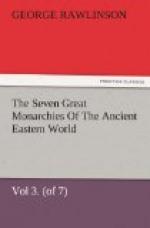The notion that the Zend language was the idiom of ancient Media originated with Anquetil du Perron. He looked on Zoroaster as a native of Azerbijan, contemporary with Darius Hystaspis. His opinion was embraced by Kleuker, Herder, and Eask; and again, with certain modifications, by Tychsen and Heeren. These latter writers even gave a more completely Median character to the Zendavesta, by regarding it as composed in Media Magna, during the reign of the great Cyaxares. The main foundation of these views was the identification of Zoroastrianism with the Magian fire-worship, which was really ancient in Azerbijan, and flourished in Media under the great Median monarch. But we have seen that Magianism and Zoroastrianism were originally entirely distinct, and that the Zendavesta in all its earlier portions belongs wholly to the latter system. Nothing therefore is proved concerning the Zend dialect by establishing a connection between the Medes and Magism, which was a corrupting influence thrown in upon Zoroastrianism long after the composition of the great bulk of the sacred writings.
These writings themselves sufficiently indicate the place of their composition. It was not Media, but Bactria, or at any rate the north-eastern Iranic country, between the Bolor range and the Caspian. This conclusion, which follows from a consideration of the various geographical notices contained in the Zend books, had been accepted of late years by all the more profound Zend scholars. Originated by Rhode, it has also in its favor the names of Burnouf, Lassen, Westergaard, and Haug. If then the Zend is to be regarded as really a local dialect, the idiom of a particular branch of the Iranic people, there is far more reason for considering it to be the ancient speech of Bactria than of any other Arian country. Possibly the view is correct which recognizes two nearly-allied dialects as existing side by side in Iran during its flourishing period—one prevailing towards the west, the other towards the east—one Medo-Persic, the other Sogdo-Bactrian—the former represented to us by the cuneiform inscriptions, the latter by the Zend texts. Or it may be closer to the truth to recognize in the Zendic and Achsemenian forms of speech, not so much two contemporary idioms, as two stages of one and the same language, which seems to be at present the opinion of the best comparative philologists. In either case Media can claim no special interest in Zend, which, if local, is Sogdo-Bactrian, and if not local is no more closely connected with Media than with Persia.
It appears then that we do not at present possess any means of distinguishing the shades of difference which separated the. Median from the Persian speech. We have in fact no specimens of the former beyond a certain number of words, and those chiefly proper names, whereas we know the latter tolerably completely from the inscriptions. It is proposed under the head of the “Fifth Monarchy” to consider at some length the general character of the Persian language as exhibited to us in these documents. From the discussion then to be raised may be gathered the general character of the speech of the Medes. In the present place all that will be attempted is to show how far the remnants left us of Median speech bear out the statement that, substantially, one and the same tongue was spoken by both peoples.




